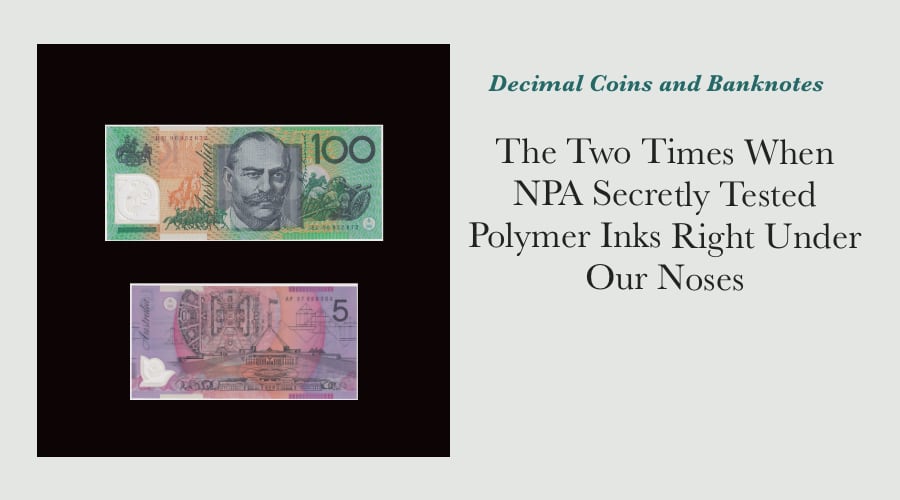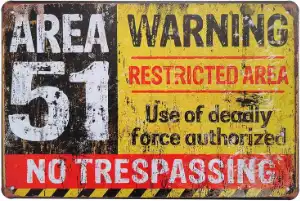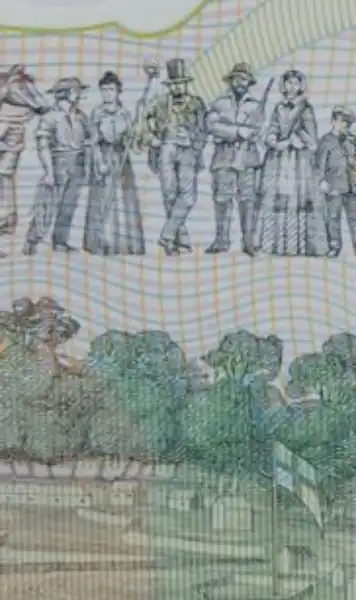The Two Times When NPA Secretly Tested Polymer Inks Right Under Our Noses

What do Area 51, Pine Gap, and that $5 note in your wallet have in common? More than you might think.
Each one represents a clandestine government program hidden in plain sight.

Area 51 Warning Sign
Area 51 is the holy grail of conspiracy theories - what can be more compelling than alleged alien technology meeting cutting-edge military research? Pine Gap is Australia's enigma - a joint signals facility where even elected Australian officials have limited access. Both facilities are managed by governments acting in the interest of the general public, but we're just not allowed to know anything about them!
In 1996, the Reserve Bank of Australia (RBA) ran an exclusive production run of $100 polymer test notes to determine whether a specific change to the opacifying ink was warranted. There was no advance notice given to the general public; the polymer test notes were simply released into circulation, and their longevity under the rigours of usage was measured. The only way we've learned anything about them at all is due to the curiosity and persistence of a handful of experienced collectors.

Intaglio ink on a polymer note
Opacifying Ink Helps Other Inks Adhere to the Polymer Substrate
Most collectors of polymer banknotes will be aware that intaglio ink is used to outline the fine lines of design on either side of a note and that simultan inks provide the background or the base layers of the polymer note designs.
What they may not know is that an opacifying ink is unique to a polymer note - they are used to colour the transparent substrate so the simultan and intaglio inks can then be applied. An opacifying ink was never required in the printing process of paper banknotes.
Whereas intaglio and simultan inks are commercially available printing inks that don't need to be modified for use on a polymer note, advice from Note Printing Australia (NPA) is that an opacifying ink is tailored to match the characteristics of the polymer substrate being used.
Here's the Lowdown on the 1996 $100 Test Notes

1996 100 Dollar Test Note
An exclusive sheet of 32 notes was printed for the 1996 $100 test note series. The serial prefixes ranged from AN to AZ, BN to BZ and CN to CS. At first glance, these prefixes look like they fit straight into the published prefix range of AA96 to JK96, but in practice, they sit outside the conventional serial prefix range. Until this test run in 1996, no letters after the letter M had been used in the serial prefixes of any Australian polymer note. This restriction of prefixes is one of the security devices NPA used to maintain the secrecy of the test note run.

Opacifying ink on a polymer note
When collectors have made inquiries about these polymer banknotes in the past, the Reserve Bank of Australia (RBA) has advised that the print run of $100 notes for circulation scheduled for 1996 was interrupted so these test notes could be printed and issued.
Not every serial number was used on these test notes either - the range runs from 999999 through to 648001, which works out to be 351,999 notes per serial prefix.
Theoretically, this represents a total print run of 11,263,968 $100 test notes, although it's understood that only around 10,000,000 test notes were actually issued. Errors in production and polymer banknotes used for the physical evaluation accounted for the difference. These numbers mean the 1996 test notes are ten times rarer than the standard $100 notes issued in the same year. When collectors try shooting for a specific prefix such as AN96 or CS96, the tiny mintage of just 351,999 notes per serial prefix means they are incredibly tough to come by, particularly in mint condition.
The New Opacifying Ink Passed Internal Testing and The Notes Were Released
On-site testing of the modification to the opacifying ink by the RBA determined that there was no discernible difference between the appearance of the opacifying ink on the regular notes and the ink used on the test notes. The modified ink was declared a success and the test notes were released into circulation. The Reserve Bank has previously advised that small quantities of the $100 test notes were released in late 1996, and the balance was released in 1997.
Collectors have not yet advised whether they've spotted a discernible difference between notes that have the modified opacifying ink and those printed earlier, but it will be interesting to see if differences are identified in future.
The Second Clandestine Polymer Ink Test- the 1997 $5 Notes

1997 Polymer 5 Dollar Test Note
A further run of polymer test notes was conducted in 1997, except this time the $5 note was used. The print run used in this test was much smaller, so these notes are much rarer than the $100 test notes from 1996. Again, they can be identified by the serial prefixes used on the notes included.
Once the standard print run of $5 notes for 1997 was identified, an additional sheet of 40 notes was printed. Those notes had prefixes ranging from AN to AZ, BN to BZ and then CN though to DN. Although these notes look like they sit within the conventional prefix ranges of AA to AM, BA to BM and so on, they are actually outside the published prefix range of BA 97 to HB 97. This restriction of prefixes is one of the security features NPA used to maintain the secrecy of the test run of polymer banknotes.
The RBA has not advised whether the polymer banknotes in this test used the same opacifying ink tested in 1996 or whether it was a different opacifying ink again. The RBA has previously advised that printing of the regular 1997 $5 polymer banknotes was interrupted to print these test notes.
The serial number range runs from 999999 to 990229, which works out to be only 9,771 polymer banknotes per prefix and just over 390,000 polymer banknotes in total. Compare that 9,771 to the 351,999 per serial prefix for the $100 polymer test notes, and you can see how much rarer the 1997 $5 test notes are.
The 1997 $5 Test Notes Were Not Released Until 2001
The RBA has previously advised that approximately 300,000 of the notes were released into circulation in late 2001, presumably once all of the commemorative $5 polymer banknotes printed to celebrate the Centenary of Federation had been issued. Errors in production and notes used for physical evaluation account for the 90,000 difference. This means that the initial estimate of a modest 9,771 notes per serial prefix is too high - the actual number could be as low as 7,500 notes per prefix. (Total number issued of 300,000 divided by 40 prefixes = 7,500).
The 1997 test notes are around 150 times rarer than the standard $5 notes issued in the same year. When collectors try shooting for a specific prefix such as AN97 or DN97, the tiny mintage of just 7,500 notes per serial prefix means they are incredibly tough to come by, particularly in mint condition.
The RBA has previously advised that the Federation $5 polymer banknotes issued in 2001 were the first Australian polymer banknotes that used the modified opacifying ink, which means internal testing of the 1997 test notes must have been so overwhelmingly positive that it was sent straight into production on the new notes before the test notes were even released into circulation.
While we can probably forget about getting a memento from Area 51 or Pine Gap, it is still possible to obtain examples of the test notes from 1996 and 1997 in mint condition. The collector working on a budget could aim for an example of each from circulation; the focused collector could obtain a mint example of a standard prefix for both denominations, while the really serious collector could aim to get one of the rarest first or last prefixes in mint condition.